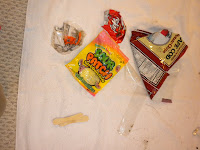Tuesday, 6/22, 7:30AM saw me in the car on the way to Bay View. It had been 6-7 days since my first collection. I didn't know what to expect. I had scoured my two zones well the week before. But it had been hot & sunny (by Maine standards) -- and also early days of school vacation. What would an under-the-radar local beach offer?
A first glance on the N zone suggested an active week:
Signs of life at the party log
Caffeinated chain-smoking
I dug in. And I have to say, whatever I expected from zone N, this wasn't it.
205 finds!
- Building materials: 1 (piece of wooden lathe/fence rail)
- Foam/Styrofoam: 9
- Food-related plastics: 38 (inc. Hershey's, Rice Krispies Treats, AirHeads, various gum wrappers, 3 straws/stirrers, Listerine Cool Mint single-pack, "Great Value" granola bar)
- Non-food/unknown plastics: 14 (inc. 2 bubble blowers, bandaid, plastic pail sticker, Trojan packet)
- Cigarette filters: 93
- Cigarette package debris: 5
- Paper, identifiable: 7 (New England coffeecup, Hallmark store bag, Star magazine insert, salt packet, label for a folding chair, "Jack's Jokes" bubblegum joke card, scrap with food ingredients)
- Paper, unidentifiable: 5
- Glass bottle/can: 7 (2 beer bottles, beer can, can scrap, 3 bottlecaps)
- Misc: 26 (gum, 2 pieces twine, plant pot, 3 socks, wooden kite rod, 2 pieces sea glass, 16 pieces of fireworks)
A few of the highlights:
Food plastics
Non-food ID'able plastics
Unknown plastics
All of this... in six days. A few were clustered -- the party trash around the log (beer, cigs, candy, and fireworks), the chainsmoking coffee-drinker. The rest were mostly random. Most of it was fresh. (Maybe 20 things had signs of age on them -- cig butts, the can scrap, most of the foam bits, a few candy wrappers. Either I missed them on 6/16, or winds and feet shifted the sands and revealed them.) Most of it was plausibly beach-related. The one thing that struck me: nothing fishing-related. No piece of line, no claw band, nada. First time ever since starting my beach jaunts.
Of the 205 items, a lucky wind would have easily blown at least 180 of them right into the ocean. What gets me is, maybe a lucky wind did just that with another 180 some time between 6/16 and 6/22. If so, who knows where and when they'll return to land? But one way or another, they probably will.
Compared to the N zone, the S zone was a different world.
Only 32 finds here.
- Building materials: 1
- Foam/Styrofoam: 7
- Fishing rope: 2
- Fish misc/claw bands: 1 (claw band)
- Food-related plastics: 3 (inc. another "Great Value" granola bar wrapper)
- Non-food/unknown plastics: 5 (beach umbrella base, Secret deodorant scrap, tissue box lid seal)
- Cigarette filters: 10
- Misc.: (2 sea glass, winter slipper)
As found on the beach
What happened here? Washed up last week? Buried by sand until last week? Not sure. But a quick peek at the bottom reveals...
...it's made of the kind of stuff that could survive months -- or years -- at sea.
Thus ends Week #2 at Bay View. A productive -- if maybe depressing -- window into how we treat our public spaces. Zone N was mostly littered by local, recent, beach-related trash. Zone S was more likely to be older trash, seemingly brought from elsewhere.
What will the next trip bring? Who knows.





































